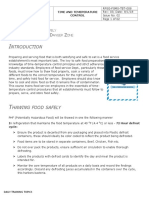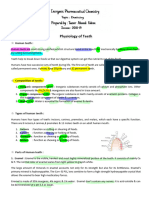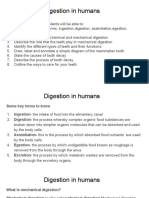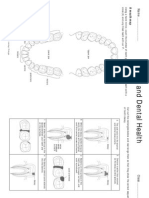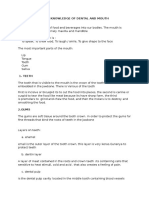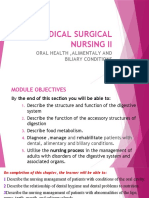1.8.8,9,10,11 Handout
1.8.8,9,10,11 Handout
Uploaded by
Sumera BokhariCopyright:
Available Formats
1.8.8,9,10,11 Handout
1.8.8,9,10,11 Handout
Uploaded by
Sumera BokhariCopyright
Available Formats
Share this document
Did you find this document useful?
Is this content inappropriate?
Copyright:
Available Formats
1.8.8,9,10,11 Handout
1.8.8,9,10,11 Handout
Uploaded by
Sumera BokhariCopyright:
Available Formats
Term: 1 Science Class 3
The City School
Handout Number: Science 1.8.8,9,10,11
Topic: Keeping Healthy
Theme: Health and Well-Being
Learning Objectives:
1.8.8. Recognise that some foods can be damaging to our teeth.
1.8.9. Define tooth decay and how to prevent it.
1.8.10. Enlist ways of protecting your teeth from tooth decay
1.8.11. State the main steps/procedures involved in treating cavities, decayed teeth or if the teeth are not growing straight.
Food damaging for our teeth.
.Our teeth can rot and get holes if we eat food and sweets that have a lot of sugar. Scientists call this
tooth decay. Dentists help us look after our teeth. They call a hole in our teeth, a cavity. If you see a
black spot on a tooth, this could be a cavity starting. A dentist may give the tooth a filling.
To prevent cavities and maintain good oral health, your diet -- what you eat and how often you eat --
are important factors. Changes start the minute you eat certain foods. Bacteria in the mouth convert
sugars and carbohydrates from the foods you eat to acids, and it's the acids that begin to attack the
enamel on teeth, starting the decay process.
Too many carbohydrates from sugars (like cake, cookies and candies) and savoury foods and starches
(like pretzels and potato chips) can cause tooth decay. The more often you eat and snack, the more
frequently you’re exposing your teeth to the cycle
of decay. The time between meals allows saliva to
wash away food particles that bacteria would
otherwise feast on. Frequent snacking, without
brushing immediately afterwards, gives bacteria
constant fuel. Try to limit snacks as much as
possible -- no more than one or two a day. Brush your teeth after each snack, if possible. Sugar can
cause gum disease. This is when your gum feels sore and may bleed.
Tooth decay
Tooth decay is caused by plaque collecting, in particular, around the gum
line, the edges of fillings and the grooved surfaces of the teeth. Plaque is
Figure 1Tooth Decay
made up of food debris, saliva and bacteria normally present in the
mouth.
Term: 1 Science Class 3
Figure 2 Plaque on teeth.
Plaque contains acids which, over time, can dissolve away the
protective, hard enamel coating of the tooth, and create holes, or
cavities.
Cavities
Most cavities form over a period of months or even years. They are usually painless, but they can grow
very large, and damage the much softer internal structures of the tooth such as the dentin and the
pulp, which is found at the core. If they remain untreated, they can kill the nerve and blood vessels of
the tooth, and ultimately the tooth itself. The most obvious sign of tooth decay is a toothache,
particularly after hot or cold foods or drinks. Pits or holes may also be visible in the teeth.
Plaque and tartar also irritate the gums and lead to gum disease.
Treatment for cavities:
Cavities are one of the most common dental problems in toddlers and children. Also referred to as tooth
decay, a cavity is a permanently damaged area in a
tooth.
1. Dental Filling: The dentist removes the tooth decay
and then fills the hole with a white composite or
Figure 3 Dental filling
metal material. Filling a cavity that forms on a
baby tooth can save or preserve the tooth.
2. Crown: In cases of severe tooth decay, your dentist might
recommend a dental crown, which is typically silver in colour.
3. Extraction: A very common reason involves a tooth that is too
badly damaged, from trauma or decay, to be repaired.
Figure 4 Decayed tooth covered with crown
4. Braces: This is a device used to straighten or align teeth if they
are not growing straight.
How to keep your teeth healthy
Our teeth need to last a lifetime. Here are some things you can do to look after them:
1. Brushing twice a day with toothpaste to remove plaque.
2. Flossing between teeth to remove any bits of food.
3. Going to the dentist.
4. Eating less sugary food and drinks.
You might also like
- Oral and Denture Care PPT Finale 1Document75 pagesOral and Denture Care PPT Finale 1Jan Joseph BanzuelaNo ratings yet
- TN 4h Poultry Record BookDocument11 pagesTN 4h Poultry Record BookDbaltNo ratings yet
- Dental Plaque PresentationDocument10 pagesDental Plaque PresentationHesham100% (1)
- Catering - TBT - 008 - Time and Temperature ControlDocument2 pagesCatering - TBT - 008 - Time and Temperature ControlNiraNo ratings yet
- Dental CariesDocument8 pagesDental CariesMiftah WiryaniNo ratings yet
- Applied NutritionDocument11 pagesApplied NutritionsfsffNo ratings yet
- Git DisordersnewDocument401 pagesGit DisordersnewstaceyatienoomaNo ratings yet
- CavitiesDocument8 pagesCavitiesMazokoza JacksonNo ratings yet
- Dental Caries Bahasa InggrisDocument4 pagesDental Caries Bahasa InggrisNOVIANA D4 2017No ratings yet
- Planed Teaching Programme On Bottle Feeding and Dental CariesDocument31 pagesPlaned Teaching Programme On Bottle Feeding and Dental CariesVaibhav JainNo ratings yet
- Dental Caries (Tooth Decay) : AnswerDocument5 pagesDental Caries (Tooth Decay) : AnswerDara Pangestika Dwi AnggraeniNo ratings yet
- Science and Technology and ICTDocument14 pagesScience and Technology and ICTsibandaanenyasha858No ratings yet
- Naim Oral CareDocument34 pagesNaim Oral Carenaim157No ratings yet
- نسخة 1Document8 pagesنسخة 12jcn78x82dNo ratings yet
- Oral Health Gateway To Good HealthDocument9 pagesOral Health Gateway To Good HealthMatias ContiNo ratings yet
- Dental PlaqueDocument6 pagesDental PlaqueZartasha Amaid ButtNo ratings yet
- Chapter 2. DentistryDocument11 pagesChapter 2. DentistryNo IdeaNo ratings yet
- Digestion in Humans (Csec Notes)Document19 pagesDigestion in Humans (Csec Notes)Akili ArmaniNo ratings yet
- TCP For Oral HygieneDocument5 pagesTCP For Oral HygieneEnrico IgamaNo ratings yet
- Enamel and Dentine Maria BarraganDocument19 pagesEnamel and Dentine Maria Barraganjobar60No ratings yet
- Represented by Group IDocument22 pagesRepresented by Group IUsman FarooqNo ratings yet
- Cavaties - WhatsMedi Content ResearchDocument4 pagesCavaties - WhatsMedi Content ResearchSiddharth ChoudheryNo ratings yet
- Careis Dentis 2Document3 pagesCareis Dentis 2zayNo ratings yet
- Management of Deep Caries LesionDocument14 pagesManagement of Deep Caries LesionCah YaniNo ratings yet
- TDocument4 pagesTAnwar RadhiNo ratings yet
- NSU Dental Products New 1Document53 pagesNSU Dental Products New 1thomaswayne0270No ratings yet
- Caries DentalesDocument4 pagesCaries Dentalesandyjosefalcon2000No ratings yet
- The Teeth: © PDST Home EconomicsDocument12 pagesThe Teeth: © PDST Home EconomicsfouadNo ratings yet
- Dental CariesDocument20 pagesDental Carieschantelle acopNo ratings yet
- HTTPDocument7 pagesHTTPErvic SitjarNo ratings yet
- BIOLOGY - Chapter 2 ppt3Document24 pagesBIOLOGY - Chapter 2 ppt3tabassum.tabuNo ratings yet
- Dental Plaque PresentationDocument10 pagesDental Plaque PresentationHeshamNo ratings yet
- Group ADocument34 pagesGroup AMahmodol HasanNo ratings yet
- Basic Knowledge of Dental and MouthDocument3 pagesBasic Knowledge of Dental and MouthMayril Yusrin SyarfinaNo ratings yet
- Dental CariesDocument14 pagesDental CariesLexina AdjeiNo ratings yet
- Oral HygieneDocument30 pagesOral HygieneNevena DimitrijevicNo ratings yet
- Oral Health Gateway To Good HealthDocument9 pagesOral Health Gateway To Good HealthMatias ContiNo ratings yet
- Oral HealthDocument4 pagesOral HealthAnuar Abdul GhaniNo ratings yet
- Bahasa - Inggris - Isu SelesaiDocument10 pagesBahasa - Inggris - Isu SelesaiUtari ZulkaidahNo ratings yet
- Science - L-1 Teeth and MicrobesDocument9 pagesScience - L-1 Teeth and MicrobesHitesh MalikNo ratings yet
- Early Childhood CariesDocument4 pagesEarly Childhood CariesAstia Dwiputri LestariNo ratings yet
- Mutans and Lactobacilli. Cavity or Decay of A Tooth Is A Localized DiseaseDocument12 pagesMutans and Lactobacilli. Cavity or Decay of A Tooth Is A Localized Diseasegie_gie123No ratings yet
- Dental TerminologyDocument86 pagesDental TerminologyREFTA DEVINo ratings yet
- Tooth Decay Easy Read GuideDocument29 pagesTooth Decay Easy Read GuideSTEM JordanNo ratings yet
- Spectacularsmiles: New Spectacular Smiles!Document4 pagesSpectacularsmiles: New Spectacular Smiles!burlesonddsNo ratings yet
- Dr. Rajeev Kumar Singh: Presented byDocument32 pagesDr. Rajeev Kumar Singh: Presented byMonalisa DebbarmaNo ratings yet
- Cavities (About, Types and Treatment) - WhatsMedi Content ResearchDocument4 pagesCavities (About, Types and Treatment) - WhatsMedi Content ResearchSiddharth ChoudheryNo ratings yet
- Caries FatehDocument13 pagesCaries FatehShubham BhagatNo ratings yet
- Teeth: Now Smile PLZDocument13 pagesTeeth: Now Smile PLZUsama FarooqNo ratings yet
- How To Start Remineralizing Your TeethDocument7 pagesHow To Start Remineralizing Your TeethÍtalo de AndradeNo ratings yet
- What Causes Cavitis PrevensionDocument2 pagesWhat Causes Cavitis PrevensionVũ ChiếnNo ratings yet
- Orthodentic Paper: Arranged By: D.Iv Dental Care Level 3.ADocument21 pagesOrthodentic Paper: Arranged By: D.Iv Dental Care Level 3.AUlil Azmi HasyimNo ratings yet
- By Mayo Clinic Staff: Click To EnlargeDocument4 pagesBy Mayo Clinic Staff: Click To EnlargeLexie DvrelsNo ratings yet
- Oral, Git, Billiary ConditionsDocument107 pagesOral, Git, Billiary ConditionsNathaniel Mbiu TimNo ratings yet
- 1 Day 1 EssayDocument1 page1 Day 1 EssayĐoàn Nhật TiếnNo ratings yet
- As Additives In: Making ToothpasteDocument26 pagesAs Additives In: Making ToothpasteJocelyn NagalizaNo ratings yet
- A Simple Guide to Bad Breath and Mouth DiseasesFrom EverandA Simple Guide to Bad Breath and Mouth DiseasesRating: 5 out of 5 stars5/5 (3)
- Dental Health and Cavities: Cavities Tooth Decay ToothDocument5 pagesDental Health and Cavities: Cavities Tooth Decay ToothKhairumi Dhiya'an AbshariNo ratings yet
- Bab Ii Tinjauan PustakaDocument24 pagesBab Ii Tinjauan PustakaRetnosari AhmadiNo ratings yet
- How To Start Remineralizing Your TeethDocument7 pagesHow To Start Remineralizing Your Teethjelissa100% (1)
- Composition of Crown Layers: Dental AnatomyDocument8 pagesComposition of Crown Layers: Dental AnatomymahmoodNo ratings yet
- PlaqueDocument10 pagesPlaquetqdqmy5kgvNo ratings yet
- Durood For Rehmat MercyDocument1 pageDurood For Rehmat MercySumera BokhariNo ratings yet
- Surah Al Muzammil Se Mushkilat Ka HalDocument51 pagesSurah Al Muzammil Se Mushkilat Ka HalSumera Bokhari0% (1)
- Definication, Role and ScopeDocument34 pagesDefinication, Role and ScopeSumera Bokhari100% (1)
- ECN-720, 603 Econometric Theory Spring 2014 - OutlineDocument4 pagesECN-720, 603 Econometric Theory Spring 2014 - OutlineSumera BokhariNo ratings yet
- Concept of Public Administration With Referenc To IslamDocument31 pagesConcept of Public Administration With Referenc To IslamSumera Bokhari85% (13)
- SentenceDocument12 pagesSentenceSumera BokhariNo ratings yet
- Contemporary Issues and Challenges in Management Practice and Theory-LibreDocument18 pagesContemporary Issues and Challenges in Management Practice and Theory-LibreSumera BokhariNo ratings yet
- Demutualization of Stock ExchangesDocument25 pagesDemutualization of Stock ExchangesSumera BokhariNo ratings yet
- Spelling Bee Word ListDocument8 pagesSpelling Bee Word ListKaren SerranoNo ratings yet
- 231 Student ResumeDocument4 pages231 Student ResumetempNo ratings yet
- Cattleya: - TemperatureDocument1 pageCattleya: - TemperaturefebeyNo ratings yet
- Cake Craft & Decorating 2013'01Document84 pagesCake Craft & Decorating 2013'01Alexa RodsNo ratings yet
- Japanese Soy Souce (JFSSMC) 2008kanekoDocument17 pagesJapanese Soy Souce (JFSSMC) 2008kanekoLeinadNo ratings yet
- Project Report SiddharthDocument70 pagesProject Report SiddharthSiddharth PatidarNo ratings yet
- 6360 18721 1 PBDocument9 pages6360 18721 1 PBwillyNo ratings yet
- LP in CO1 Substitution of Ingredients G7 CookeryDocument12 pagesLP in CO1 Substitution of Ingredients G7 CookeryGrace Villanueva PalitNo ratings yet
- Bumagat Angela Thea A. Block C SGD8Document2 pagesBumagat Angela Thea A. Block C SGD8SEBASTIEN ANDREI BUENAFENo ratings yet
- EnglishFile4e Intermediate TG PCM Comm 10BDocument1 pageEnglishFile4e Intermediate TG PCM Comm 10BB McNo ratings yet
- Australian - Gourmet.traveller March.2022Document158 pagesAustralian - Gourmet.traveller March.2022MarianWbm100% (1)
- Third Homework U7 Grammar L2Document3 pagesThird Homework U7 Grammar L2alejandramonreal126No ratings yet
- MG303 Product Assignment 2023Document20 pagesMG303 Product Assignment 2023s11175122No ratings yet
- Cardinal Corporate Event: (Since 2021)Document77 pagesCardinal Corporate Event: (Since 2021)Rci-Ched Mira CaparasNo ratings yet
- Drug and Alcohol ProcedureDocument2 pagesDrug and Alcohol ProcedurefrancoNo ratings yet
- Semiotic Analysis - Chupa ChupsDocument2 pagesSemiotic Analysis - Chupa ChupsMaria CasertaNo ratings yet
- Classification of FoodDocument19 pagesClassification of FoodMuhammad HannanNo ratings yet
- Экзаменационные билетыDocument4 pagesЭкзаменационные билетыsasa sasaNo ratings yet
- My Family and Friends Ate Dinner at A Local Restaurant Every Saturday Night When I Was YoungerDocument4 pagesMy Family and Friends Ate Dinner at A Local Restaurant Every Saturday Night When I Was YoungerMARJGONo ratings yet
- Cassida WGDocument3 pagesCassida WGRaghavendra MurthyNo ratings yet
- BÀI TẬP TỔNG HỢP VỀ THÌ HIỆN TẠIDocument5 pagesBÀI TẬP TỔNG HỢP VỀ THÌ HIỆN TẠIvananhNo ratings yet
- Bacterial Contaminants Associated With The Hands of Food Handlers at Ahmadu Bello University, ZariaDocument7 pagesBacterial Contaminants Associated With The Hands of Food Handlers at Ahmadu Bello University, ZariaUMYU Journal of Microbiology Research (UJMR)No ratings yet
- ICSE Economics3Document6 pagesICSE Economics3Ritesh SinghNo ratings yet
- 40 Inventive Principles With Applications in ServiDocument16 pages40 Inventive Principles With Applications in Servisina yadegariNo ratings yet
- Performance Guidelines For Refillable KegsDocument46 pagesPerformance Guidelines For Refillable KegsDiego Suazo PlazaNo ratings yet
- Customs and Culture of The Amerindians Lesson PlanDocument4 pagesCustoms and Culture of The Amerindians Lesson Planvenomwolf484No ratings yet
- Soal B.inggris SMP 9 PpadDocument36 pagesSoal B.inggris SMP 9 Ppadlattesummer8No ratings yet
- Cargo Advice - Soya BeansDocument5 pagesCargo Advice - Soya Beansjim100% (1)



